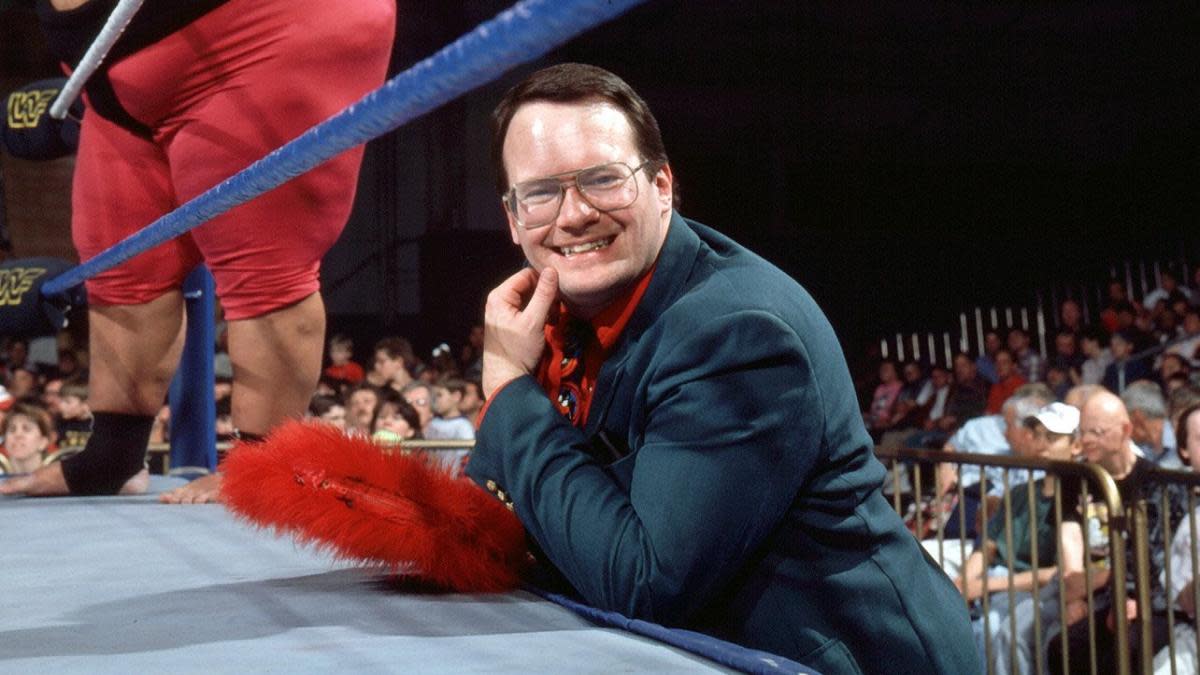A Plane Crash, a Fan With a Gun and More Stories from Jim Cornette’s Book, ‘Behind the Curtain’

Jim Cornette served as one of professional wrestling’s greatest managers, and he is now finding his voice as one the most captivating writers on the business.
After 35 years of working ringside, Cornette has penned “Behind The Curtain”, a graphic novel—or comic book, as he prefers—that examines new angles to some of wrestling’s most fascinating stories.
“The comic book is full of true wrestling stories, but most of them have a twist,” said Cornette. “Now everybody knows about Ric Flair’s plane crash and how doctors told him he might not walk and might never wrestle, then 40 years later, he’s the greatest wrestler of all time. But a lot of people have forgotten that ‘Mr. Wrestling’ Tim Woods was also in the plane crash and actually checked himself out of the hospital to protect the business. He was a babyface, and he wrestled on TV the next weekend to prove that the rumors he was on the plane with the heels were not true.”
Follow SI Wrestling on Facebook
Follow

Cornette, who also runs two successful podcasts in “Jim Cornette’s Drive-Thru” and “The Jim Cornette Experience”, spoke from his home in Louisville, Kentucky. He noted that even though the book is being sold as a graphic novel, the pages depict true stories.
“We’re telling the true stories,” said Cornette. “The story with the Fabulous Freebirds involves the time they had blinded Junkyard Dog. Bill Watts [of Mid-South Wrestling] paid the Dog money every week to stay home and sell that he was blind until he made his big return. They even told the story that Dog couldn’t see his daughter that was just about to be born, all to juice up the story for the Superdome, where he was going to face Michael Hayes in a dog-collar match.
“Dog was sitting ringside in New Orleans with the other babyfaces when the Freebirds jumped the other guys, then made the motion to the crowd that they were going to attack Junkyard Dog. This guy from the crowd then hopped the rail, right next to Dog, who was sitting there with glasses, a cane, and acting like he can’t see. Then, this guy from the crowd pulled out the biggest gun Dog said he’d ever seen. The man yelled, ‘Don’t worry, Dog, I got ‘em!’
“At this point, Dog had to figure, ‘Do I tackle this guy and blow the whole deal to save the Freebirds’ lives because he’s fixing to shoot them? And if I do that, will Watts fire me for exposing the business?’ But while Dog was thinking about that, the cops tackled the guy and got the gun away from him.”
Cornette’s rookie year in wrestling came in the summer of 1976 as a 14-year-old photographer, ring announcer, and self-proclaimed gopher for Louisville promoter Christine Jarrett, then he made his first appearance on Memphis television six years later in August of 1982 in a storyline created by promoter Jerry Jarrett that saw him announce his intentions to become a manager.
His managerial debut took place in September of ’82, when he earned $50 standing ringside in support of U.S. Ladies tag team champions Sherri Martel and Leilani Kai in their successful tag title defense over Velvet and Vivian St. John at the Cook Convention Center in Memphis.
“We’ll have stories like that, from the modern days all the way back to Strangler Lewis and his promoter with a suitcase of $70,000 in cash paying off another promoter,” said Cornette. “We have some cool s--- in the book.”

Cornette started a Kickstarter to fund the book, which has already exceeded his original goal of $25,000. The additional money raised will go directly to enhancing the book.
“We’re adding pages and adding features,” said Cornette. “Maybe even adding gimmick wrestling posters or having people paying to become ancillary characters, like the pilot on Flair’s plane. It’s really cool, and people have hopped all over it.”
A proud wrestling historian, Cornette remains tough to please when it comes to modern-day wrestling. He reviewed WrestleMania 34 for his podcast and came away, for the most part, impressed.
“There was the ridiculous, but there was also the sublime,” said Cornette. “I thought the Rousey match was the best major league debut in the history of wrestling. They did the right thing at the right time at the right pace and took people on a roller coaster ride. That, to me, was a pro wrestling match.
“I couldn’t find fault with it, except I wish that Ronda had come out with her game face on when she did her entrance. She was so thrilled to be coming out at WrestleMania that she was smiling, but otherwise, it was perfect.”
As for Braun Strowman pulling a child from the crowd to win the tag team titles, you don’t need a degree in psychology to know Cornette was not a fan.
“There has to be some level at which you say, ‘No, this is too much, it shows disrespect to what our athletes do,’” said Cornette. “You can make kids and fans happy without calling them on the court in the last three minutes of the NBA Finals. Even if it’s a blow-away game, there is no way little Joey is going out on the court.”
Cornette promised his new book will incorporate the best storytelling from the current age of wrestling, while serving as a reminder of the business’ rich history of compelling stories from nearly 100 years ago.
“It’s better quality printing than the wrestling magazines we used to prize,” said Cornette. “You get a lot of content and a lot of quality.”
Justin Barrasso can be reached at JBarrasso@gmail.com. Follow him on Twitter @JustinBarrasso.
